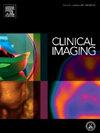Imaging features and preoperative diagnostic insights of esophageal schwannomas as a rare type
IF 1.8
4区 医学
Q3 RADIOLOGY, NUCLEAR MEDICINE & MEDICAL IMAGING
引用次数: 0
Abstract
Purpose
We aimed to analyze and summarize the key features of esophageal schwannomas to provide new insights into preoperative diagnosis and enhance clinical recognition.
Methods
Twenty-one consecutive patients with pathologically confirmed esophageal schwannoma who underwent surgical resection between January 2013 and January 2023 were enrolled. Imaging results from barium swallow, CT, MRI, 18F-FDG PET-CT, esophagoscopy, and endoscopic ultrasound were compiled and analyzed.
Results
Our cohort comprised 10 males and 11 females, with mean age of 55.86 ± 9.09 years. The mean tumor size was 5.69 ± 1.32 cm, with tumors commonly located in the upper to middle esophagus. 83.3 % (10/12) presented smooth filling defects with intact canal walls in barium meal. Most tumors (71.4 %, 15/21) were oval-shaped, exhibiting intracavitary growth with well-defined borders. Mild enhancement was observed on CT with pre-contrast attenuation of 36.0 ± 53.87 HU and post-contrast enhancement of 52.75 ± 7.45 HU. Most lesions showed plateau dynamic enhancement on MRI (85.7 %, 6/7). Air crescent signs (95.2 %, 20/21) and fascicular signs (87.5 %, 7/8) were observed in most cases. Neither calcifications nor target signs were observed, and cystic changes were infrequent. All lesions showed high uptake on PET-CT (SUVmax: 11.19 ± 3.41). Endoscopic lesions typically exhibit smooth surfaces, soft textures, and colors ranging from normal to slightly lighter hues (94.7 %, 18/19). Endoscopic ultrasound indicated minimal blood flow within lesions (53.8 %, 7/13), and elastography displayed a blue-green pattern (100 %, 5/5).
Conclusion
Esophageal schwannomas exhibit distinct imaging characteristics. MRI provides additional diagnostic information for more accurate evaluation, while high metabolic activity on PET-CT may mimic malignancy.
食管神经鞘瘤是一种罕见类型,其影像学特征及术前诊断意义
目的分析和总结食管神经鞘瘤的主要特征,为术前诊断提供新的思路,提高临床认知度。方法选取2013年1月至2023年1月间经病理证实的食管神经鞘瘤患者21例。汇总分析吞钡、CT、MRI、18F-FDG PET-CT、食管镜、超声内镜等影像学结果。结果本组患者男性10例,女性11例,平均年龄55.86±9.09岁。肿瘤平均大小为5.69±1.32 cm,肿瘤多位于食管上至中段。83.3%(10/12)表现为管壁完整的平滑充填缺陷。大多数肿瘤(71.4%,15/21)呈椭圆形,表现为腔内生长,边界明确。CT轻度增强,对比前衰减36.0±53.87 HU,对比后增强52.75±7.45 HU。多数病变MRI表现为平台动态强化(85.7%,6/7)。多数病例为气月牙征(95.2%,20/21)和束状征(87.5%,7/8)。未见钙化或靶征,囊性改变少见。所有病变PET-CT均显示高摄取(SUVmax: 11.19±3.41)。内镜下病变通常表现为表面光滑,质地柔软,颜色范围从正常到稍浅(94.7%,18/19)。内镜超声显示病灶内血流极少(53.8%,7/13),弹性成像显示蓝绿色(100%,5/5)。结论食管神经鞘瘤具有明显的影像学特征。MRI为更准确的评估提供了额外的诊断信息,而PET-CT上的高代谢活性可能模拟恶性肿瘤。
本文章由计算机程序翻译,如有差异,请以英文原文为准。
求助全文
约1分钟内获得全文
求助全文
来源期刊

Clinical Imaging
医学-核医学
CiteScore
4.60
自引率
0.00%
发文量
265
审稿时长
35 days
期刊介绍:
The mission of Clinical Imaging is to publish, in a timely manner, the very best radiology research from the United States and around the world with special attention to the impact of medical imaging on patient care. The journal''s publications cover all imaging modalities, radiology issues related to patients, policy and practice improvements, and clinically-oriented imaging physics and informatics. The journal is a valuable resource for practicing radiologists, radiologists-in-training and other clinicians with an interest in imaging. Papers are carefully peer-reviewed and selected by our experienced subject editors who are leading experts spanning the range of imaging sub-specialties, which include:
-Body Imaging-
Breast Imaging-
Cardiothoracic Imaging-
Imaging Physics and Informatics-
Molecular Imaging and Nuclear Medicine-
Musculoskeletal and Emergency Imaging-
Neuroradiology-
Practice, Policy & Education-
Pediatric Imaging-
Vascular and Interventional Radiology
 求助内容:
求助内容: 应助结果提醒方式:
应助结果提醒方式:


